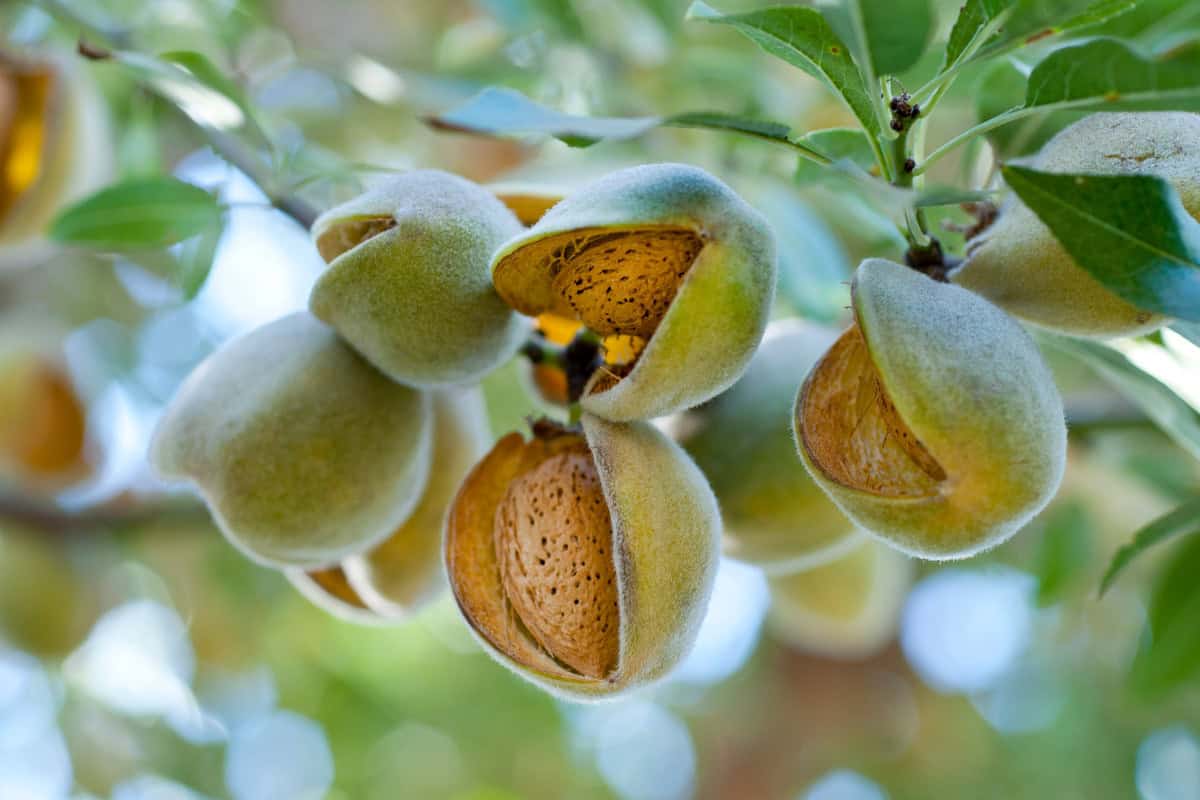
This comprehensive Almond firewood profile explores California’s premium orchard wood, delivering 27,000-30,000 BTUs per cord with exceptional heating characteristics and sustainable sourcing.
Whether you’re planning serious cold-weather heating or need clean-burning hardwood with excellent coaling properties, almond offers outstanding performance combined with the satisfaction of using agricultural byproducts rather than native forest resources.
- Quick Reference Stats: Almond Firewood Profile
- Overview & Identification
- Geographic Distribution
- Burning Characteristics
- Sensory Experience
- Processing & Preparation
- Specialized Uses
- Pros & Cons
- Best Practices & Tips
- Bottom Line: Almond Firewood Profile
- 🌰 Almond Firewood Quick Reference Table 🔥
- Related Resources: Almond Firewood Profile
Quick Reference Stats: Almond Firewood Profile
- Wood Type: Hardwood (fruit tree family)
- BTU Rating: 27,000-30,000 BTUs per cord
- Ease of Splitting: Moderate to Difficult (2.5/5 scale)
- Seasoning Time: 9-12 months
- Smoke Production: Very Low
- Spark/Pop Factor: Very Low
- Scent Profile: Pleasant – Mild, nutty aroma
Overview & Identification
Almond stands as California’s premium agricultural firewood, delivering exceptional heat output comparable to the finest hardwoods while representing sustainable use of orchard resources.
This dense hardwood provides outstanding performance with clean burning characteristics and minimal ash production.
Many consider it an excellent choice that combines top-tier heating performance with environmental responsibility.
Common Names: Almond, Sweet Almond
Scientific Name: Prunus dulcis (family Rosaceae)
Tree Characteristics: Small to medium deciduous tree typically reaching 20-30 feet in height (up to 40 feet in ideal conditions). Features willow-like leaves and pink-white flowers with five petals. Related to cherries, plums, and other stone fruits.
Geographic Distribution
Where You’ll Find It: Primarily California’s Central Valley and coastal regions, with 80% of world’s almond production. Limited cultivation in other Mediterranean climate regions including parts of the Middle East, Mediterranean basin, and small areas of Australia.
Availability: Excellent availability in California’s Central Valley and Bay Area from orchard replacement programs
Growing Conditions: Thrives in Mediterranean climates with hot, dry summers and mild, wet winters. Requires cross-pollination and is heavily dependent on honeybee populations for commercial production.
Burning Characteristics
Heat Output & Performance
- BTU Content: Exceptional performance delivering 20% more heat per cord than oak
- Burn Duration: Burns long and steadily with excellent heat retention
- Coaling Properties: Forms outstanding coals that maintain heat for extended periods
- Flame Characteristics: Burns hot with steady, intense flames that transition to excellent coal beds
Ignition & Fire Management
- Ease of Lighting: Can be challenging to ignite due to density – requires good kindling or established fire
- Best Fire Stage: Excellent primary fuel for serious heating and outstanding for overnight burns
- Burn Rate: Slow, steady consumption provides maximum heat output per log
- Heat Consistency: Very reliable, steady heat output with minimal temperature variation
Sensory Experience
Smoke Profile
- Smoke Volume: Very low smoke production when properly seasoned
- Smoke Color: Minimal, clean smoke with excellent dispersal
- Smoke Flavor: Mild, nutty flavor suitable for cooking applications
- Creosote Production: Very low due to clean burning characteristics and low sap content
Sound & Visual
- Crackling/Popping: Quiet burning with minimal crackling
- Sparking Tendency: Very low spark production – excellent safety profile
- Flame Appearance: Impressive, steady flames with consistent burn pattern
Aroma
- Burning Scent: Pleasant mild nutty fragrance characteristic of the species
- Pleasant Factor: Widely appreciated – subtle, not overwhelming
- Intensity: Light to moderate aromatic presence that’s distinctly nutty
Processing & Preparation
Splitting Characteristics
- Ease of Splitting: Moderate to difficult due to density and occasional twisted grain
- Grain Pattern: Generally straight but can be twisted from orchard pruning practices
- Tools Needed: Heavy maul or hydraulic splitter recommended for knotty pieces
- Best Splitting Conditions: Split when green if possible – becomes harder when dry
Seasoning Requirements
- Drying Time: 9-12 months for adequate seasoning – faster than oak but slower than softer hardwoods
- Moisture Content: Target 15-20% moisture content for optimal burning performance
- Seasoning Tips: Dense wood benefits from good splitting and excellent air circulation
- Storage Considerations: Stack off ground with top cover – excellent storage characteristics
Processing Notes
- Chainsaw Considerations: Dense wood that can dull chains – maintain sharp equipment
- Bark Characteristics: Smooth to slightly rough bark, typically greyish-brown
- Handling: Heavy, dense wood – plan for significant weight when moving
Specialized Uses
Sustainable Sourcing
- Agricultural Byproduct: Primarily sourced from orchard replacement rather than native forest cutting
- Environmental Benefit: Uses farm-raised wood instead of cutting native oaks and hardwoods
- Zero Waste: Part of almond industry’s zero-waste approach to orchard management
- Renewable Resource: Represents sustainable use of agricultural land transitions
Cooking Applications
- Cooking Suitability: Excellent for cooking due to clean burn and mild flavor
- Flavor Profile: Imparts subtle nutty flavor – lighter than other fruit woods
- Cooking Stage: Outstanding for maintaining steady cooking temperatures
- Food Safety: Clean burning makes it safe and ideal for all cooking applications
Pros & Cons
Advantages
- Exceptional BTU output – 20% higher than oak
- Burns very clean with minimal smoke production
- Outstanding coaling properties for extended heat
- Environmentally responsible – agricultural byproduct
- Faster seasoning than oak (9-12 months vs 2+ years)
- Very low ash production – easy cleanup
- Excellent safety profile with minimal sparking
- Pleasant, mild nutty aroma
- Dense wood provides long burn times
Disadvantages
- Limited geographic availability – primarily California
- Can be challenging to split due to density and twisted grain
- Premium pricing outside California markets
- Challenging to ignite without established fire
- Heavy, dense wood makes handling demanding
- Orchard replacement cycles affect consistent availability
- May not be available during drought years affecting orchards
- Requires good splitting technique due to hardness
Best Practices & Tips
Fire Pit Optimization
- Ideal Fire Size: Perfect for serious heating applications and overnight burns
- Mixing Recommendations: Excellent primary fuel – combine with easier-lighting kindling
- Safety Considerations: Outstanding safety characteristics make it ideal for all applications
- Weather Suitability: Exceptional performance in cold weather conditions
Purchasing & Storage
- What to Look For: Dense, heavy pieces with characteristic nutty scent when fresh
- Pricing Expectations: Premium pricing – typically 20-30% above standard hardwoods
- Storage Lifespan: Excellent storage characteristics when properly seasoned and protected
Bottom Line: Almond Firewood Profile
Almond represents the premium choice for California fire pit users who want exceptional heat output combined with environmental responsibility.
While it requires effort to process and commands premium pricing, the outstanding BTU performance, clean burning characteristics, and sustainable sourcing make it an excellent choice for serious heating applications and environmentally conscious consumers.
Best For: California residents, environmental sustainability, serious heating applications, clean burning needs, and those wanting agricultural alternatives to forest wood
Skip If: You’re outside California markets, need easily split wood, require budget-friendly options, or lack experience with dense hardwoods
For a visual breakdown of almond firewood’s elite stats, burning traits, and sustainable advantages, see the reference table below!
🌰 Almond Firewood Quick Reference Table 🔥
Almond firewood is California’s powerhouse—it’s dense, clean-burning, and produces long-lasting coals. With a slow burn, pleasant nutty aroma, and top-tier sustainability, almond is the ultimate premium choice for serious heating and eco-conscious fires.
| Characteristic | Rating/Value | Notes |
|---|---|---|
| 🔥 BTU per Cord | 27,000-30,000 | 20% higher than oak |
| ⚖️ Density | Very High | Dense, heavy hardwood |
| ⏰ Seasoning Time | 9-12 months | Faster than oak |
| 🪓 Splitting Difficulty | Moderate-Difficult (2.5/5)⭐ | Density and twisted grain |
| 💨 Smoke Production | Very Low | Exceptionally clean |
| ✨ Spark/Pop Factor | Very Low | Excellent safety profile |
| 🚀 Ignition Ease | Challenging | Needs established fire |
| ⚡ Burn Rate | Slow | Long burn times |
| 🔥 Coaling Ability | Excellent | Outstanding coal formation |
| 🌸 Scent Quality | Pleasant | Mild nutty aroma |
| 🍳 Cooking Suitability | Excellent | Clean burn, mild flavor |
| 🌱 Sustainability | Outstanding | Agricultural byproduct |
| 📍 Regional Availability | California Primary | Limited elsewhere |
| 💰 Cost Level | Premium | Reflects quality and availability |
| 🎯 Best Use | Serious heating, sustainability | California’s premium choice |
| 🏆 Overall Rating | Outstanding performance and sustainability |
Related Resources: Almond Firewood Profile
Last updated: 8/22/2025


